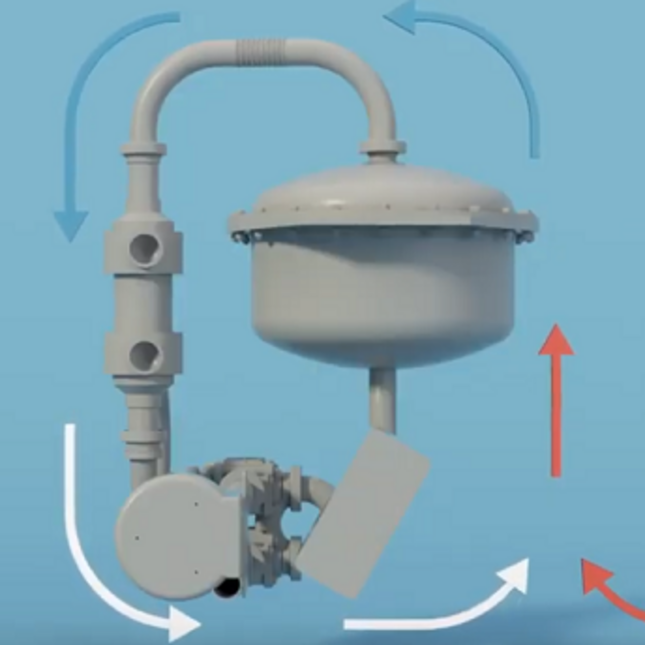Is our heat battery really loss free? (The answer is yes)
And seven other questions about the innovative heat battery that TU/e is developing to temporarily store energy as heat in your home.

The costs, the losses, the required amount of salt, the size, the usability as a barbecue: the questions we received about our heat battery after our request (thanks for that!) were relevant, diverse and occasionaly surprising. This battery, which TU/e is currently developing with companies and knowledge institutions, is inexpensive, compact and loss-free. We presented all questions to principal investigator prof. Olaf Adan. In this article we give you the answer to the eight most interesting questions.
1. How does this not violate Laws of Thermodynamics? Is it that there is no loss of energy, or that the loss is very small?
Matthew Corcoran (USA)
The ‘loss-free’ aspect of the heat battery was clearly impressive. Many readers, such as Matthew, wondered whether zero energy loss was even possible, and whether the researchers aimed to violate a fundamental law of physics. Fortunately, that is not the case, Adan does not intend to build a perpetual motion machine.
So what is it about then? The heat battery is about loss-free storage. The heat once stored in the battery is never lost. With other storage methods, such as with water or phase change materials, there is always a cooling effect and you lose stored heat over time. This does not happen in this heat battery: thermochemical storage is completely loss-free.
How is that possible? Central to the heat battery is the combination of water vapor and salt. If you bring those components together, a reaction occurs in which the water binds to the salt and heat is released. Compare it to making plaster, in which you add water to a calcium sulfate. This also gets a little warm.
The reaction also works the other way around: by adding heat you can separate the water and salt again. Adan calls this "drying a salt", since you end up with dry salt powder. Now, as long as you keep the water and salt separate – and you have dry salt powder –, the energy is always stored in it.
The heat must initially come from somewhere, which is probably what many readers referred to. And indeed, when the heat goes in or out of the battery, so during the conversion, some energy is lost as also the device itself is heating up or cooling down. However, that is still very little. And, as mentioned, once that heat is in the battery, the storage itself is loss-free.
2. With which energy source is the system powered?
Dirk-Jan Braker (The Netherlands)
The great thing is: both thermal and electrical energy can be added to the battery. So whether it is a solar collector on your roof, via a heat network or with electricity from solar panels or wind: it is all possible. Of course any electricity must first be converted to heat before it can be stored in the battery.
3. How much salt do you need to get through the winter from November to April?
René Sluiter (The Netherlands)
We also saw this question come back more often. However, the answer is not very easy to give. First of all, it is important to make clear that you continuously charge and discharge the heat battery throughout the year, the battery works ‘multicyclically’. So you don’t charge the battery once in the winter and then use it until April. In that case you would need a very large volume of salt – several cubic meters – that is used only once a year, which is, according to Adan, both impractical and inefficient.
It’s not necessary though, as there is enough energy available to ‘charge’ the battery during the year. In winter, there may be periods when there is not enough sun and wind , but in the Netherlands the worst case scenario is two weeks. That is a time frame that the battery can bridge easily.
How much salt you need for this, depends – naturally – on the amount of heat to be stored. This is different for every home, depending on factors such as the number of people in the household, the energy consumption or how well insulated a house is. But for a typical situation of a four-person household in a normally insulated house, Adan is thinking of a device the size of a washing machine, with a few hundred kilograms of salt.
4. Is it possible to install the battery in every house?
Johny Berkvens (The Netherlands)
Whether the heat battery fits in a house, depends on the heat demand - regardless of the size of the house - as already mentioned. A small one-person newly-built home requires a much smaller-sized battery than an eight-person household in a decrepit old building. The researchers estimate it will fit in a large proportion of the houses.
In addition to individual homes, the heat battery can be used for groups of homes, such as an apartment complex. According to Adan, one of the strong points of the battery is that it is easy to scale up. The system is modular, and you simply need more salt for a larger storage volume. Certainly with small apartments, where a system would take up a relatively large amount of space in every home, it can be quite conceivable that you install one larger system for an entire complex.
5. Can the technology be used in conjunction with other heat sources, such as heat pumps?
Chris Thomson (United Kingdom)
Yes, as a matter of fact the heat pump and the heat battery form an excellent combination, says Adan. The heat battery makes the heat pump perform better. This is why: the greater the temperature difference that a heat pump has to bridge, the poorer the efficiency. This is often the case in winter, when tap water has to be heated from temperatures around freezing to the usual 65 degrees Celsius.

The heat battery can take over part of this process. The water pump heats the water up to 20 degrees Celsius, intended for space heating, and the heat battery takes the step from 20 to 65 degrees Celsius. As a result, the heat pump has a much better efficiency and consumes less electricity. This can have major consequences: heat pumps could become smaller and cheaper and less investment may perhaps be needed to increase the capacity of the power grid.
6. How much will the heat battery cost and when will it be available to test or buy it?
Olawale Olaigbe (United Kingdom)
A relevant question, and at the same time very difficult to answer conclusively. Adan makes a cautious estimate that the cost of the first generation that is now being developed comes to around ten euros per megajoule of storage. That is considerably cheaper than competing technologies: the costs are ten to fifteen times lower than with electric storage.
Adan hopes the device will be on sale in about three years. The first practical tests are expected to take place in homes in the Netherlands, France and Poland starting from 2022. He is currently very busy with the preparations.
7. Will the heat battery have IoT (internet of things) features and an app / platform to visualize the status of it in real time for use and/or maintenance?
Tadeo Vera Mora (Italy)
That's certainly the intention, according to Adan. Coincidentally, a project has just been started to develop the technology to determine the state of charge of the battery, in other words, how full or empty the battery is. According to Adan, that is a lot more complicated than it may seem. Ultimately, this and other battery status information should indeed be trackable in an app or web application.
8. Can you also barbecue with it?
Arjan Geluk (The Netherlands)
A very original question, which Adan himself had never thought of before! Unfortunately we will have to disappoint Arjan, with the heat from this battery we are not able to grill your burger. The heat battery heats water up to about 60 degrees Celsius, which is far from enough to prepare meat…
Help us develop novel ways to store energy
Are you interested in the research of Olaf Adan? Want to join our researchers in their goal to develop novel ways of energy storage? Check out what Eindhoven University of Technology has to offer.
